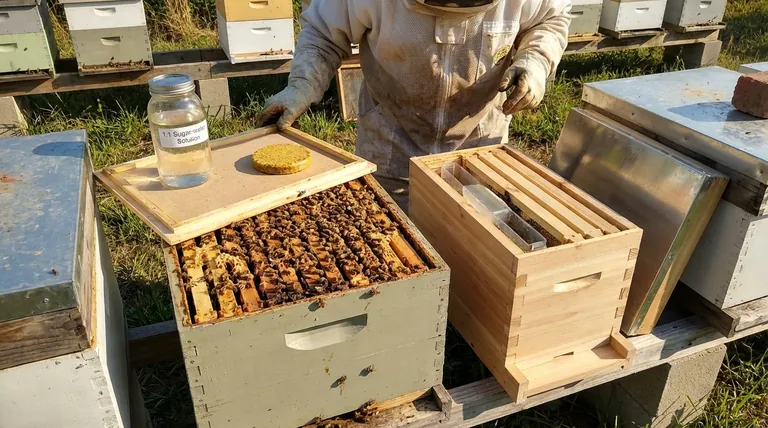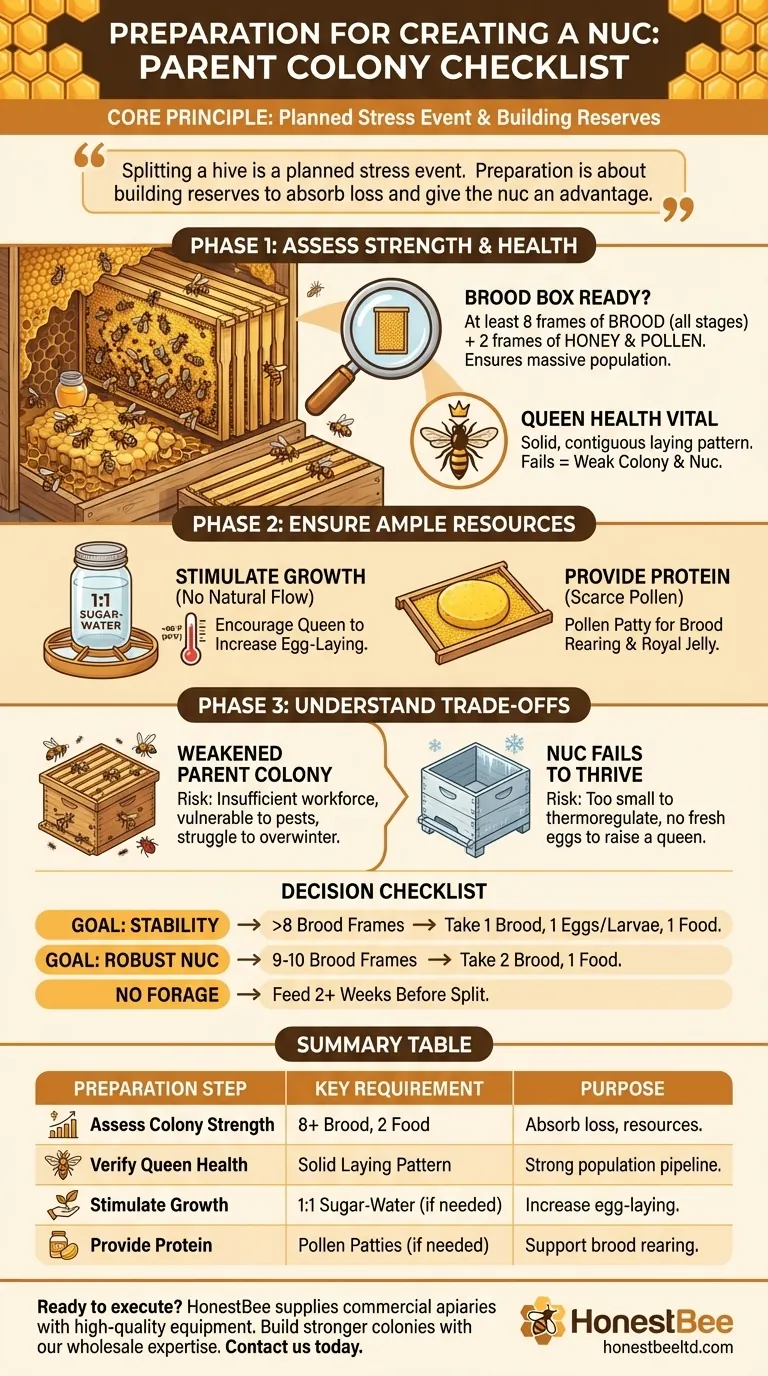To properly prepare a parent colony for creating a nuc, you must ensure it is strong, populous, and has abundant resources. This involves verifying it has at least eight frames of brood and two of food, and if a natural nectar flow is absent, stimulating growth by feeding a 1:1 sugar-water solution and pollen patties.
The core principle is this: splitting a hive is a planned stress event. Your preparation is about building up the parent colony's reserves so that it can easily absorb the loss of bees and brood, while simultaneously providing the new nuc with an overwhelming advantage for survival and growth.

Assessing the Health and Strength of the Parent Colony
Before you can take from a colony, you must first verify it has more than enough to give. A strong parent hive is the single most important factor in the success of both the original hive and the new nuc.
What "Strong" Looks Like in the Brood Box
A colony is typically considered ready for a split when its brood chamber is bustling. Look for a hive with at least eight frames covered in brood of all stages and an additional two frames of honey and pollen.
This density ensures that the parent colony has a massive population of worker bees and a deep pipeline of emerging bees to quickly replace the frames you remove.
The Importance of a Laying Queen
A strong population is a direct result of a healthy, productive queen. Before splitting, inspect the brood frames for a solid, contiguous laying pattern.
Spotty or inconsistent brood patterns can indicate a failing queen. Splitting a colony with a weak queen is a recipe for failure, as it compromises the health of both the parent and the nuc.
Ensuring Ample Resources for Growth
Bees need resources to fuel expansion. Your job is to ensure they have an uninterrupted supply of carbohydrates (nectar/sugar) and protein (pollen) leading up to the split.
Stimulating Growth with Feeding
If there isn't a strong natural nectar flow, you must simulate one. Begin feeding the parent colony a 1:1 sugar-water mixture once daytime temperatures are consistently above 60°F (15°C).
This supplemental feeding doesn't just prevent starvation; it actively stimulates the queen to increase her egg-laying rate, rapidly building the population needed for the split.
Providing Necessary Protein
Brood rearing is protein-intensive work. If you don't see bees returning to the hive with full pollen baskets, it's wise to provide a pollen patty.
This ensures the nurse bees have the protein required to produce royal jelly and feed the developing larvae, which is critical for raising healthy new bees in both colonies post-split.
Understanding the Trade-offs
Creating a nuc is an act of division. Done correctly, you create two thriving colonies. Done carelessly, you can create two weak ones that are vulnerable to failure.
The Risk of Weakening the Parent Colony
The most common mistake is splitting a colony too early or taking too many resources. This can leave the parent hive with an insufficient workforce to forage, defend the hive, and care for the remaining brood.
A weakened parent colony is susceptible to pests like wax moths and small hive beetles, and may struggle to rebuild its population in time for the main nectar flow or to survive the next winter.
Creating a Nuc That Fails to Thrive
The nuc itself is inherently vulnerable. If you do not provide it with enough capped brood, the initial population will be too small to thermoregulate the hive and defend it.
Furthermore, a nuc must have a frame containing freshly laid eggs. Without eggs, the bees have no way to raise a new queen, and the colony is doomed unless you introduce one manually.
Making the Right Choice for a Successful Split
Your preparation should align with your specific goals for the hives. Use this checklist to confirm the parent colony is ready.
- If your primary focus is parent colony stability: Ensure the hive has more than the minimum eight frames of brood before taking only one frame of capped brood, one frame of eggs/larvae, and one frame of food.
- If your primary focus is creating a robust, fast-growing nuc: Wait until the parent colony is overflowing with bees and has 9-10 frames of brood, allowing you to confidently pull two frames of brood and one of food.
- If you are facing a lack of natural forage: Begin feeding at least two weeks before your planned split to ensure the colony is in a state of expansion, not conservation.
Proper preparation transforms a hive split from a gamble into a predictable and rewarding step in your beekeeping journey.
Summary Table:
| Preparation Step | Key Requirement | Purpose |
|---|---|---|
| Assess Colony Strength | At least 8 frames of brood, 2 frames of food | Ensure the hive can absorb the loss of bees and resources. |
| Verify Queen Health | Solid, contiguous brood pattern | Guarantee a strong population pipeline for both colonies. |
| Stimulate Growth | Feed 1:1 sugar-water solution if no natural nectar flow | Encourage queen to increase egg-laying rate. |
| Provide Protein | Offer pollen patties if natural pollen is scarce | Support brood rearing and healthy bee development. |
Ready to execute a successful nuc split with confidence? Proper preparation is key, and having the right equipment is just as crucial. At HONESTBEE, we supply commercial apiaries and beekeeping equipment distributors with the high-quality, durable supplies needed for every stage of beekeeping—from hive bodies and frames to feeding systems. Let our wholesale-focused expertise help you build stronger colonies. Contact our team today to discuss your equipment needs and ensure your next split is a thriving success.
Visual Guide

Related Products
- 5 Frame Wooden Nuc Box for Beekeeping
- HONESTBEE Professional Long Handled Hive Tool with Precision Cutting Blade
- HONESTBEE Advanced Ergonomic Stainless Steel Hive Tool for Beekeeping
- Professional Dual-End Stainless Steel Hive Tool for Beekeeping
- Multi-Function Plier-Style Frame Grip Hive Tool
People Also Ask
- What are the benefits of starting a new bee colony in a nuc box? Boost Colony Success with Efficient Beekeeping
- What is the most common type of standard nuc? The 5-Frame Nuc Explained
- What is the advantage of overwintering a nucleus? A Strategic Asset for Beekeeping Success
- What frames should be moved into the queenless hive when requeening with a nuc? Ensure a Successful Queen Introduction
- What is the purpose of having a nuc in beekeeping? Build a Resilient & Productive Apiary



















